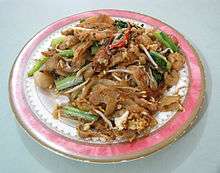Kwetiau goreng
|
Kwetiau goreng in a restaurant in Indonesia served with acar pickles and fried shallot sprinkles | |
| Alternative names | Kuetiau goreng or Kwetiaw goreng |
|---|---|
| Course | Main course |
| Place of origin | Indonesia[1] Singapore |
| Region or state | Nationwide |
| Creator | Chinese Indonesian and Peranakan |
| Serving temperature | Hot |
| Main ingredients | Fried flat noodles with chicken, meat, beef, prawn or crab |
|
| |
Kwetiau goreng (Indonesian for "fried flat noodle") is a Chinese Indonesian[2] and Malay Singaporean stir fried flat rice noodles,[1] it is a flavorful and spicy fried noodle dish common in Indonesia. It is made from locally known kwetiau(粿條) (shahe fen or 河粉 hé fěn in Chinese) stir fried in cooking oil with garlic, onion or shallots, beef, chicken, fried prawn, crab or sliced bakso (meatballs), chili, Chinese cabbage, cabbages, tomatoes, egg, and other vegetables with ample of kecap manis (sweet soy sauce).[2] In Asia kwetiau is available in two forms, dried and wet one.[3] Its recipe is quite similar with another Chinese Indonesian favourite; mie goreng with exception replacing yellow wheat noodles with flat rice noodle.[3]
Ubiquitous in Indonesia, it can be found everywhere in the country, sold by all food vendors from traveling street-hawkers in their carts, warungs, to high-end restaurants. It is one of Indonesian one-dish meal favorite, although street food hawkers commonly sell it together with mie goreng and nasi goreng (fried rice). Kwetiau goreng is also served in Indonesian franchise restaurants such as Es Teler 77.[4]
Its closest analogue probably is char kway teow popular in neighboring Malaysia and Singapore. However, it is slightly different, since Indonesian kwetiau goreng usually tastes mildly sweet with generous addition of sweet soy sauce, spicier with addition of sambal chili sauce as condiment, and mostly halal using chicken and beef, and the absence of pork and lard to cater Muslim majority population. However, some Chinese restaurants in Indonesia that serve non-Muslim customers might use pork and lard. The most common protein source for kwetiau goreng however, are beef, chicken, prawns or crab.[2]
For the Muslim population in Malaysia, char kway teow is often called kwetiau goreng. In fact, the term kwetiau goreng in Malaysia refer to the halal version of char kway teow which prefer beef and chicken while omitting pork and lard.[5]
Origin
Chinese influences is evident in Indonesian food, such as bakmi, mie ayam, pangsit, mie goreng and kwetiau goreng.[6] The dish is derived from Chinese stir-fried shahe fen and believed to have been introduced by Chinese immigrants in Indonesia for centuries. The Chinese first made contact with the Indonesian in the 7th century, and by 1600s Chinese settlements have already sprung up along the coast of Java and Sumatra.[1] With centuries of interactions between the two cultures, resulting the blend of Chinese and local cuisine.
Kwetiau goreng is very similar to Chinese Malaysian and Singaporean char kway teow.[7] However, kwetiau goreng has been more heavily integrated into Indonesian cuisine; for example the application of popular sweet soy sauce that add mild sweetness, stronger flavor, sprinkle of bawang goreng fried shallots, addition of spicy sambal to add spiciness, also might add krupuk topping to add crispy texture, and the absence of pork and lard in favour for shrimp, chicken or beef; to cater for the Muslim majority Indonesians.
Variations

Just like mie goreng, kwetiau goreng recipes might vary according to its ingredients. The popular variants are kwetiau goreng sapi (beef),[8] kwetiau goreng ayam (chicken), kwetiau goreng seafood (seafood including cuttlefish, prawn and fish) and kwetiau goreng kepiting (crab). The kwetiau goreng pedas (hot and spicy) uses a lot of chili pepper, while kwetiau goreng sayuran mainly uses vegetables.[3]
Another popular kwetiau recipes is called kwetiau kuah (kwetiau with soup) kwetiau ayam (chicken kwetiau with soup) and kwetiau siram (poured kwetiau), that instead of stir frying, the flat rice noodles are boiled or poured with thick soup or sauce instead. Another variant called kwetiau bun, similar to kwetiau goreng but more moist and soft with the more addition of water.[9]
There is a variation called kwetiau goreng lenjer, which is made by slicing the pempek and mixing it with chicken, prawns, eggs, bean sprouts and soy sauce.[10]
See also
References
- 1 2 3 Anita (July 11, 2013). "Kwetiau Goreng – Stir Fried Flat Rice Noodles". Daily Cooking Quest. Retrieved September 3, 2014.
- 1 2 3 Nicole (November 4, 2015). "A Guide on What To Eat in Indonesia Part II". That Food Cray.
- 1 2 3 Tim Dapur DeMedia (2010). Aneka Masakan Mi, Bihun, & Kwetiau Populer (in Indonesian). DeMedia. ISBN 9789791471985.
- ↑ "Es Teller 77 becomes icon of local franchise business". The Jakarta Post. 22 January 2007. Retrieved 5 February 2016.
- ↑ "Char Kway Teow/Fried Flat Rice Noodles (炒粿條)". My Cooking Hut. 26 August 2010. Retrieved 5 February 2016.
- ↑ Heinz Von Holzen (2014). A New Approach to Indonesian Cooking. Marshall Cavendish International Asia Pte Ltd. p. 15. ISBN 9789814634953. Retrieved 5 February 2016.
- ↑ "Indonesian Noodle Dishes". Indonesian Cuisine. 17 November 2015. Retrieved 5 February 2016.
- ↑ Anita (14 July 2013). "Kwetiau Goreng Sapi – Stir Fried Beef and Flat Rice Noodles". Daily Cooking Quest. Retrieved 5 February 2016.
- ↑ "Flat Rice Noodles with Gravy (Kwetiau Siram)".
- ↑ "Bringing local food home". The Jakarta Post. 15 November 2009. Retrieved 5 February 2016.
External links
| Wikimedia Commons has media related to Kwetiau goreng. |